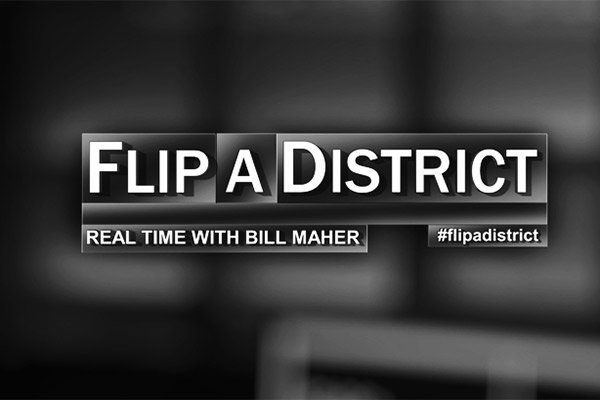As noted by Lucy Bradlow in her post, the media attention in the run up to the 2014 election was very segmented and partisan. Instead of relying on traditional media, some took their campaigns online.
On 31 January of this year comedian Bill Maher announced on his weekly news panel show that he would be aiming to “flip” a district, with an eye on the 2014 mid-term election. By this he meant that he wanted to find a seemingly safe congressional seat filled by a congressperson with a poor record and assist in making sure that candidate did not retain their position. He began promoting his #FlipADistrict on multiple social media platforms, particularly Youtube, Twitter and Facebook, to receive nominations for whom the #FlipADistrict campaign would focus on.
Over the next two months the public uploaded more than 600 videos on Youtube and tweeted over 20,000 times calling Maher to give their congressperson the Flip. In late March, Maher began naming his “Tweet 16”, which included the top 16 congresspersons that had been called out on social media. By July, Maher had found the 16 most unpopular congresspersons according to social media, and of these 16, nine were up for re-election in November.
Over the next few months, social media engagement skyrocketed in anticipation of the announcement of who would be the congressperson that Maher would focus on for the 2014 election. In July alone nearly 75,000 tweets mentioned the campaign.
In September, Maher chose to try to Flip John Kline, a Republican Representative from Minnesota who was infamous for poor education policy. Maher noted that it was students and young people fed up with “for profit” universities and increasing interest rates on student loans that led to Kline being named “the biggest loser” of Congress in the #FlipADistrict campaign. Maher continued promoting the #FlipADistract campaign through weekly mentions on his show, and pieces on traditional media (New York Times, Politico, and Washington Post). However, social media remained the focus with more than 10,000 tweets engaging in the campaign over the 2 month period leading up to the election.
In the end, Representative Kline retained his Congressional seat, with a comfortable 17 point lead and it seems as if Maher’s campaign had no impact. However, was this just a case of not meeting its potential?
Throughout the “Tweet 16” stage of the campaign, where the most congresspersons were being reviewed and therefore the most constituencies involved, there were multiple spikes of more than 15,000 tweets on 8 July and 16 July and obvious enthusiasm in the public. These spiked occurred during and after Maher’s weekly show when he would promote conversations about the #FlipADistrict campaign online. It was not until Maher named Representative Kline as the focus of the campaign (a relative unknown outside of his own state) that participation began to decline.
The exclusivity of naming just one candidate from an isolated state halted the momentum that the campaign had garnered throughout the summer. If social media engagement had continued in the same trajectory it had in the summer, the #FlipADistrict campaign could have counted on around 150,000 tweets throughout September and October, instead of only 10,000. This added social media pressure could have changed the race in Minnesota and elsewhere.
The map below shows the tweet engagement in the campaign in Minnesota, which was disappointing given the high level of engagement over the summer:
Minnesota
However, the campaign did have a victory. One of the “Tweet 16” was in fact voted out of his seat, helped by the social media attention Maher’s campaign provided over the summer. Representative Steve Southerland of Florida was narrowly defeated in a tough vote and only a 3,000 vote difference. The map below shows the engagement that occurred in Florida.
Florida
Obviously in that race every little bit of social media attention made a difference and the #FlipADistrict campaign help oust a Representative who was unpopular with his constituents (with only 36% of constituents saying they wanted him to be re-elected).
What should really be taken away from the #FlipADistrict campaign is the importance of inclusivity in social media campaigns. Social media is perfect for reaching large audiences and rallying people around a cause. Social media campaigns perform much better when the campaign can grow and eventually go viral, and sometimes move around the whole globe. Maher essentially guaranteed that his social media campaign would not be successful when he decided to focus on engaging the only 600,000 people in Kline’s Minnesota voting district. In the future he would do well to have a broader focus to his campaign and maybe in 2016 he can flip more than just one seat out of 16.


